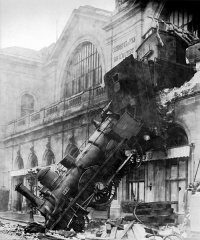Machine Age
From The Art and Popular Culture Encyclopedia
|
"ANOTHER aspect of the contemporary situation that in its distinctive character is consistent with the trends seen in modern architecture, painting, and sculpture is found in the world of the industrial arts. We cannot help observing the enormous advance, in appearance and in efficiency, in the everyday things of our present world — in “five-and-ten” products, clothing, jewelry, furnishings, silver, glass, tools, automobiles — the list is endless. And it may well be that the twentieth century is witnessing the truth of the prophecy of James Jackson Jarvis in 1864, which bears repetition, in part: “His [the American’s] clipper-ships, fire engines, locomotives, and some of his machinery and tools combine that equilibrium of lines, proportions, and masses, which are among the fundamental causes of abstract beauty . . . and is an indication of what may happen to the rest of his work when he puts into it an equal amount of heart and knowledge.” That time appears to have arrived and to have provided a healthy situation, because here art and the people meet as they do not meet in the seclusion of studios, museums, and collections. And it may well be that future generations will look upon the utilitarian, machine-made products of modern industry as the most forthright expression of the twentieth century, in the first place, because they express “the felt necessities of the time” (Justice Oliver Wendell Holmes), and in the second place, because they display high esthetic quality." --Gardner's Art Through the Ages (1926) by Helen Gardner |
|
Related e |
|
Featured: |
Machine Age is a term associated with the early 20th century. Considered to be at a peak in the time between the first and second World Wars it forms a late part of the Industrial Age and was utimately eclipsed by the Atomic Age beginning in 1945.
Contents |
Arts and architecture
The Machine Age is considered to have influenced:
- Dystopian movies including Chaplin's Modern Times and Lang's Metropolis
- Streamline Moderne appliance design and architecture
- Bauhaus style
- Steampunk
- Modern art
- Der Geist Unserer Zeit - Mechanischer Kopf (Mechanical Head [The Spirit of Our Age]) (c. 1920) by Raoul Hausmann
- Portrait of an American Girl in the Nude by Picabia
- Cubism
- Art Deco decorative style
- Futurism
- Music
Artifacts of the Machine Age
- Mass production of high volume goods on moving assembly lines, particularly of the automobile
- Gigantic production machinery, especially for producing and working metal, such as steel rolling mills, bridge component fabrication, and automobile body presses
- Powerful earthmoving equipment
- Steel framed buildings of great height (the skyscraper)
- Radio and phonograph technology
- High speed printing presses, enabling the production of low cost newspapers and mass market magazines
- Large hydroelectric and thermal electric power production plants and distribution systems
- Low cost appliances for the mass market that employ fractional horsepower electric motors, such as the vacuum cleaner and the washing machine
- Fast and comfortable long distance travel by railroad, automobile, and aircraft
- Development and employment of modern war machines such as tanks, aircraft, submarines and the modern battleship
Social influence
- The rise of mass market advertising and consumerism
- Nationwide branding and distribution of goods, replacing local arts and crafts
- Nationwide cultural leveling due to exposure to movies and network broadcasting
- Replacement of skilled crafts with low skilled labor
- Growth of strong corporations through their abilities to exploit economies of scale in materials and equipment acqusition, manufacturing, and distribution
- Corporate exploitation of labor leading to the creation of strong trade unions as a countervailing force
Environmental influence
- Exploitation of natural resources with little concern for the ecological consequences; a continuation of 19th century practices but at a larger scale
- Release of synthetic dyes, artificial flavorings, and toxic materials into the consumption stream without adequate testing for adverse health effects
International relations
- Conflicts between nations regarding access to energy sources (particularly oil) and material resources (particularly iron and various metals with which it is alloyed) required to ensure national self-sufficiency. Such conflicts were contributory to two devastating world wars.
See also



